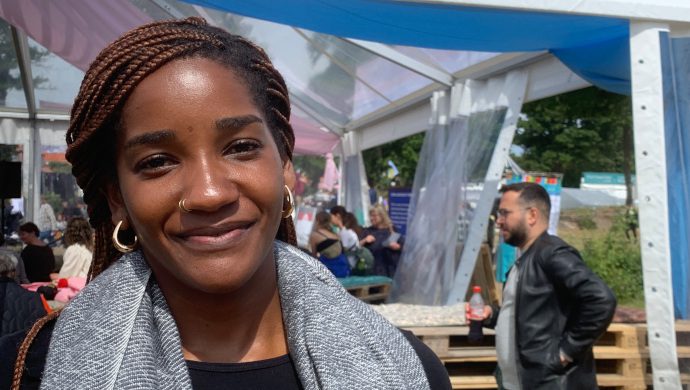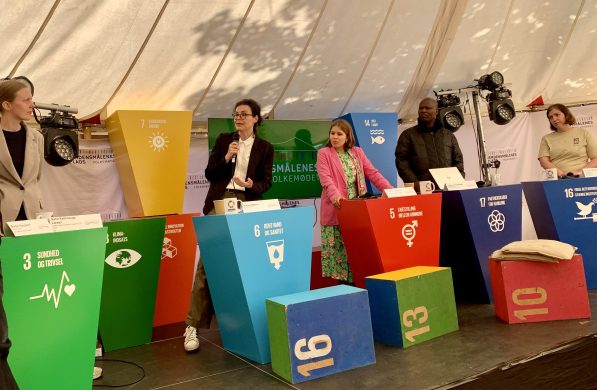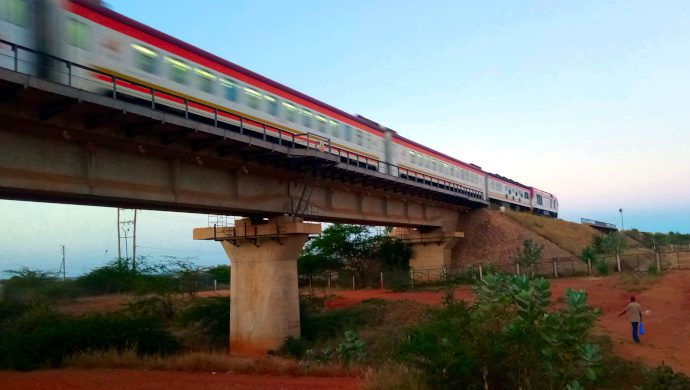Fattigdommens grimme ansigt stikker frem over alt i byerne af blikskure, hvor hundredtusinder må affinde sig med levevilkår, vi vanskeligt kan forestille os i Vesten – det har Kenyas 50 års jubilæumsfest i torsdags ikke bødet stort på – om overhovedet.
NAIROBI, 4 December 2013 (IRIN): In Mathare, a sprawling slum in Kenya’s capital, Nairobi, children in tattered (pjaltede) clothes play with raw waste flowing from a burst sewage pipe (ødelagt kloakrør).
In the alley (gyden), crowded with tin (blik)-and-wood shanties (skure), a food kiosk filled with people feasting on smoked fish stands on the burst pipe. Close by, a woman fries (steger) chopped potatoes on an open fire.
Uninsulated (ikke-isolerede) electricity cables hang precariously (faretruende) in people’s single-storey houses.
The residents know the dangers, but they have little choice.
They are not part of the national power grid (elnet) and might never have a legal connection.
A water-vending (vandsalgs) kiosk stand beside two dirty, poorly constructed pit (åbne) latrines.
Overcrowding and few resources
“The crisis of poor infrastructure, overcrowding, few resources and poor sanitation facilities is worsened further by a high disease and morbidity (dødeligheds) burden”, Bessie Nikhozi, assistant programme manager of urban livelihoods and social protection at Concern Worldwide, told IRIN.
“This is characterized by high levels of malnutrition among children and the aged and high rate of communicable (smitsomme) diseases like typhoid, malaria, dysentery and tuberculosis, with most families being unable to afford medical care. Health facilities are also limited, unequipped (uden medikamenter) and understaffed,” added she.
Paul Odero, a 27-year-old father of two and a resident of Mathare, told IRIN.
“Here we share everything because nobody can afford anything of his own. We share latrines, and these people selling food near the latrine have no space to put their kiosks. It must be near there because that is where you can find space.”
He added, “We have no place to dispose (skaffe os af med) our garbage (affald), and we just throw it anywhere. At times, you find children playing with used sanitary pads (bind) because the woman and girls who use it have nowhere to take it to. The children get diarrhoea and many die.”
Disease
In 2012, in a span of just six months, at least three children died from electrocution while playing with illegally connected power lines.
In the same year, an illegal electricity connection caused a fire that destroyed some 300 houses, leaving thousands without shelter.
Mary Muiruri, a community health worker, told IRIN that the open dumpsites (lossepladser) and the fumes (røgen) emanating from them have meant respiratory (åndedræts) infections are rampant (omsiggribende).
“The running noses among small children you see do not mean their mothers do not care. They do, but the health risks associated with poor waste disposal means their children are constantly suffering from respiratory infections. It is that bad,” she said.
“It looks simple but many women in the slums cannot go to work because they are constantly looking after sick children. Such people can not come out of poverty because how do they get income? The unhygienic conditions make them very sick often,” Muiruri noted to IRIN.
Warnings form MSF
In 2010, the global health charity, Medicines Sans Frontiers (MSF) reported that pneumonia (lungebetændelse) and respiratory tract infections accounted for 40 percent of all consultations in its heath facilities in Kibera, a Nairobi slum.
An estimated 53 percent of those who scavenge (klunser) at a dumpsite in Dandora, another slum, have respiratory tract infections, coughs and asthma, according to Concern Worldwide.
The few toilets available in Mathare are privatized, and residents pay a user fee of five shillings (six US cent = ca. 30 øre). Many cannot afford this daily fee.
“Extremely poor people living in urban slums like Mathare are forced, on a daily basis, to significantly compromise their long-term well-being to meet their short-term survival needs. This includes pulling their children from school, engagement in transactional sex, etc.,” Ann Marie Swai, the food, income and markets coordinator at Concern Worldwide, told IRIN.

A problem the world over
Around a billion people living in the world’s cities today reside in deprived areas like Mathare, with few or no basic amenities (faciliteter).
In Afghanistan, Chad, Ethiopia and Nepal, more than 90 percent of urban populations live in such deprived areas, according to the UN-Habitat.
“It is a concern that people live in overcrowded areas without any adequate policing or electricity, which raises a lot of other issues – and particularly the protection of women and children”, Kyung-wha Kang, the deputy emergency relief coordinator for the UN Office for the Coordination of Humanitarian Affairs (OCHA), told IRIN, adding:
“They only have minimum services, and the humanitarian challenges they face can be overwhelming”.
According to the UN World Health Organization, children in Nairobi slums are two and half times more likely to die before their fifth birthday than in other areas of the city.
Can hardly afford to feed their children
Moses Owino, the district medical officer of health in Mathare, told IRIN that nutrition for children and access to healthcare is a challenge in urban slums.
“There are many young mothers who can hardly afford to feed their children, and this means the issue of malnutrition for children under five years is very high”, Owino told IRIN, noting:
“The health facility can hardly cope with the demand here. HIV prevalence is higher than the national average. Urban slums are faced with a health crisis”.
According to Concern Worldwide, “The skyrocketing costs of food have pushed an already desperate people into extreme poverty, rendering them incapable of feeding their families or paying for basic services such as healthcare, rent (husleje) and school fees.”
The organization adds:
“With no land or means of growing their own food, slum residents are entirely reliant on markets [for food]”.
“The price of maize, a basic staple food (grundnæringsmiddel) for the poorest, has increased by 133 percent over the past year, while incomes have shrunk by 21 percent, forcing families to resort to desperate measures to survive.”
Crime
Læs videre på
http://www.irinnews.org/report/99263/the-hidden-crisis-in-urban-slums














